How to Watch the 2024 Tour of Flanders, the Second Monument of the Season
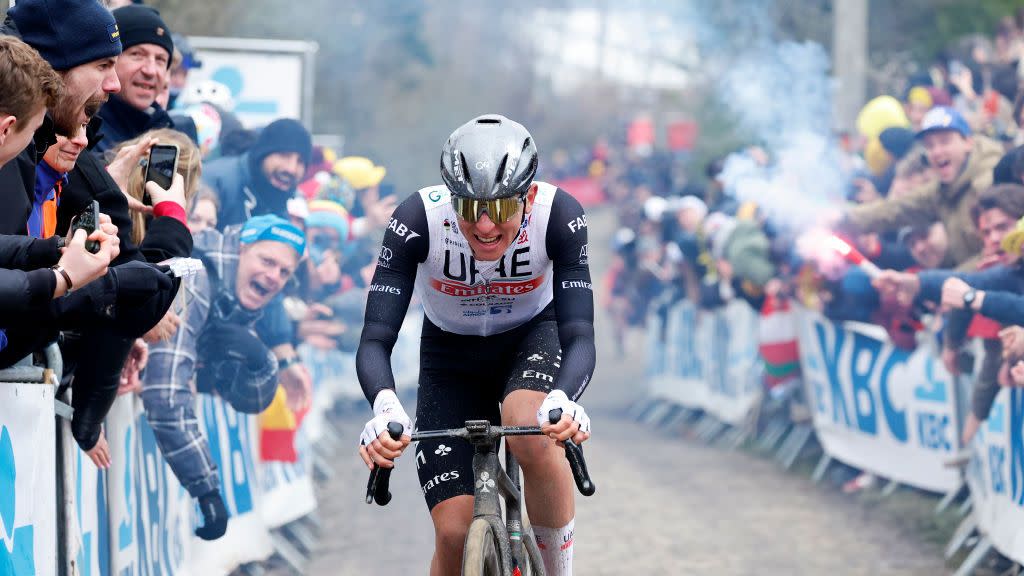
- Oops!Something went wrong.Please try again later.
- Oops!Something went wrong.Please try again later.
- Oops!Something went wrong.Please try again later.
- Oops!Something went wrong.Please try again later.
[table-of-contents] stripped
This season’s second Monument just might be the best.
The warm-up races with hard-to-say names concluded with Wednesday’s Dwars door Vlaanderen, which means it’s time for Belgium's biggest and one of the hardest races of the season: the Tour of Flanders, or as the locals call it, the Ronde van Vlaanderen.
First organized in 1913 to promote a sports newspaper and encourage regional pride in the Dutch-speaking region of Belgium, the Tour of Flanders is now known in Belgium as Vlaanderens Mooiste, the “most beautiful” race in the region (if you consider cobblestones, narrow roads, bad weather, and lots of climbs to be things of beauty).
Like many Monuments, the race has undergone many changes in its 107 editions, but its most famous characteristic has largely remained unchanged: its bergs, a relentless series of short, steep, and often cobbled climbs during the second half of the race. With roads barely wide enough for most cars to pass through, the peloton often looks like it’s preparing for a field sprint as teams try to position their riders at the front heading into these important tactical battlegrounds.
In the end, the race usually comes down to a vicious final circuit that includes six climbs and ends with the Oude Kwaremont (long and cobbled) and the Paterberg (steep and cobbled) before a fast ride to the finish in Oudenaarde.
It’s no surprise that the riders consider Flanders to be one of the hardest one-day races on the calendar. Its champions need to have strength, skill, experience, and a bit of luck to succeed. It can take years for riders to learn and master the roads, the terrain, and the weather (it’s spring in Belgium, after all).
Given the event’s complexity, Belgians have won more editions (69) of the men’s race than riders from any other nation. But that’s little consolation given that a Belgian hasn’t won the men’s race since 2017. And after home favorite Wout van Aert (Visma-Lease a Bike) broke his collarbone in Dwars door Vlaanderen, that doesn’t look likely to change this year.
A women’s Tour of Flanders was added in 2004, and the Dutch have won 8 of its 20 editions. But Belgians have enjoyed more recent success in the women’s event, with Lotte Kopecky (SD Worx-Protime) winning last year and the year before, the first woman to win back-to-back editions since Dutchwoman Mirjam Melchers won the race in 2005 and 2006.
With millions of spectators lining the course, and after weeks of anticipation, speculation, and scandals leading up to the event, the Tour of Flanders packs the drama of the Oscars, the excitement of the Tour de France, and the hype of the Super Bowl all into one single day. Here’s everything you need about de Ronde van Vlaanderen.
The Route
After last year’s race started in Bruges, this year’s 270K men’s event begins in Antwerp before heading south toward the hills of the Flemish Ardennes, a hilly region packed with short, steep (often cobbled) climbs which the locals call bergs. The first 100K of the race have been changed since the last time the race started in Antwerp. The organizers want to keep the riders on wider roads, to make the race safer.
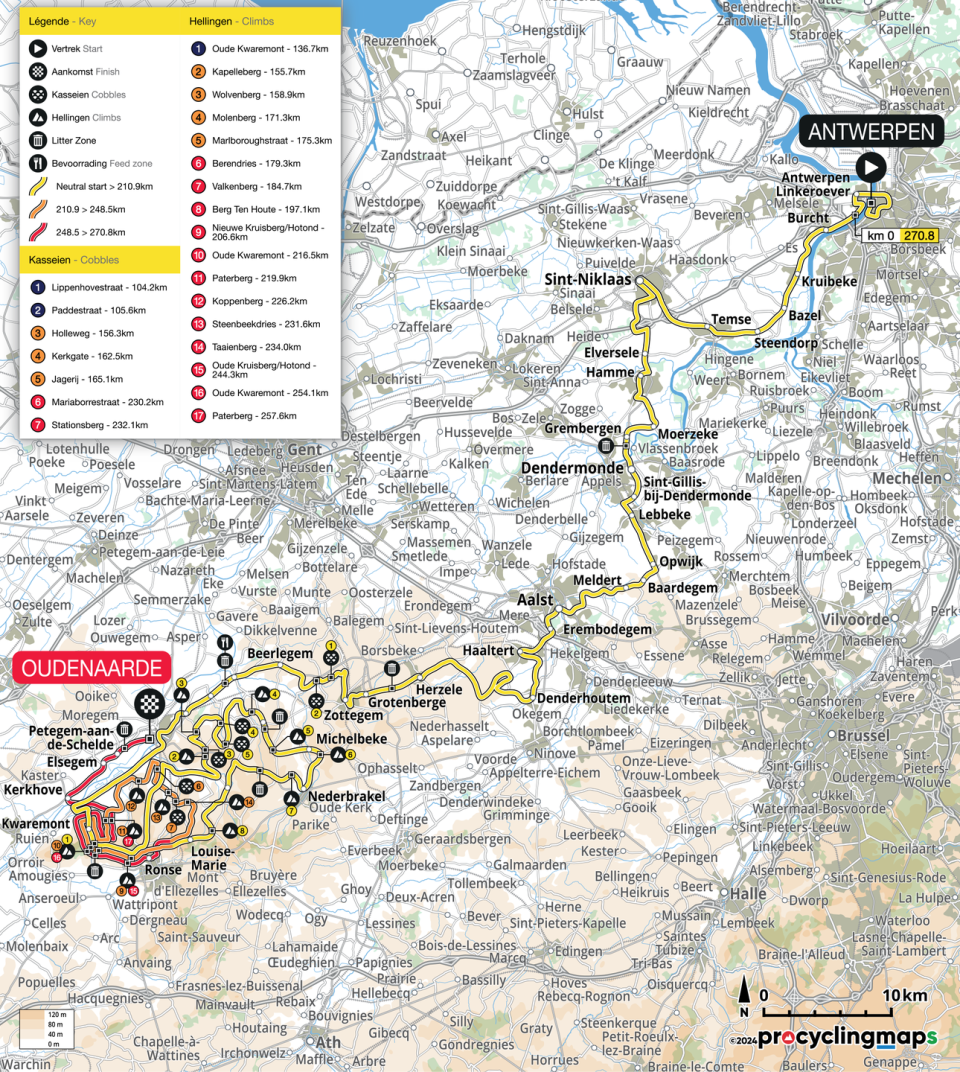
But it’s not until the race passes through Oudenaarde (home to the Tour of Flanders Museum) that the action really begins, starting with the first of the event’s 17 climbs, the Oude Kwaremont. Long, steady, and cobbled, the Oude Kwaremont pulls the pin on the second half of the race, with the race’s 16 remaining climbs coming in quick succession over the Ronde’s final 136K.
The first big loop that the men will cover takes them over ten more climbs, including famous ascents like the Molenberg, the Berendries, and the Valkenburg. This circuit ends with an important trio of climbs, one of which will return at the end of the next loop to serve as the final three climbs of the race: the Kruisberg, the Oude Kwaremont (again), and the Paterberg.
This second ascent of the Oude Kwaremont is often one of the most intense moments of the race. The teams race hard into the base of it to position their captains at the front of the race to follow any accelerations that may occur. Splits are common here, and teams hoping to win the race will hope to have multiple riders in the front group by the time they hit the summit.

But the group could split again rather quickly, as the race heads right from the Kwaremont to the Paterberg, a shorter, steeper climb that’s perfect for sharper attacks. It was on this climb that Mathieu van der Poel pulled away to win last Friday’s E3 Saxo Classic.
The second and final circuit begins with arguably the most famous (and certainly the most brutal) climb in the entire race: the Koppenberg. Super-steep, cobbled, and narrow, this is where the race’s final phase begins. Riders who don’t hit the climb at the front of the peloton are often forced to get off their bikes and walk as the sudden deceleration caused by the abrupt change in terrain ripples backward through the pack. The race is essentially over for anyone who doesn’t make it over the top of this climb in the top 25.
After the Koppenberg, five bergs remain, and recent editions have seen race-winning attacks launched on just about all of them. Lately, it’s all come down to the final ascents of the Oude Kwaremont and the Paterberg, with special attention often given to the short stretch of rolling road in between as riders try and surprise their rivals while they recover from the Kwaremont and prepare for the Paterberg, the Ronde’s final climb.
From the top of the final ascent of the Paterberg, it’s only 13.2K to the finish line in Oudenaarde, a distance that several riders have covered alone in recent years. If there is a sprint, it will be between just a handful of classics specialists; the race is too hard to see a large group hit the finish line together.
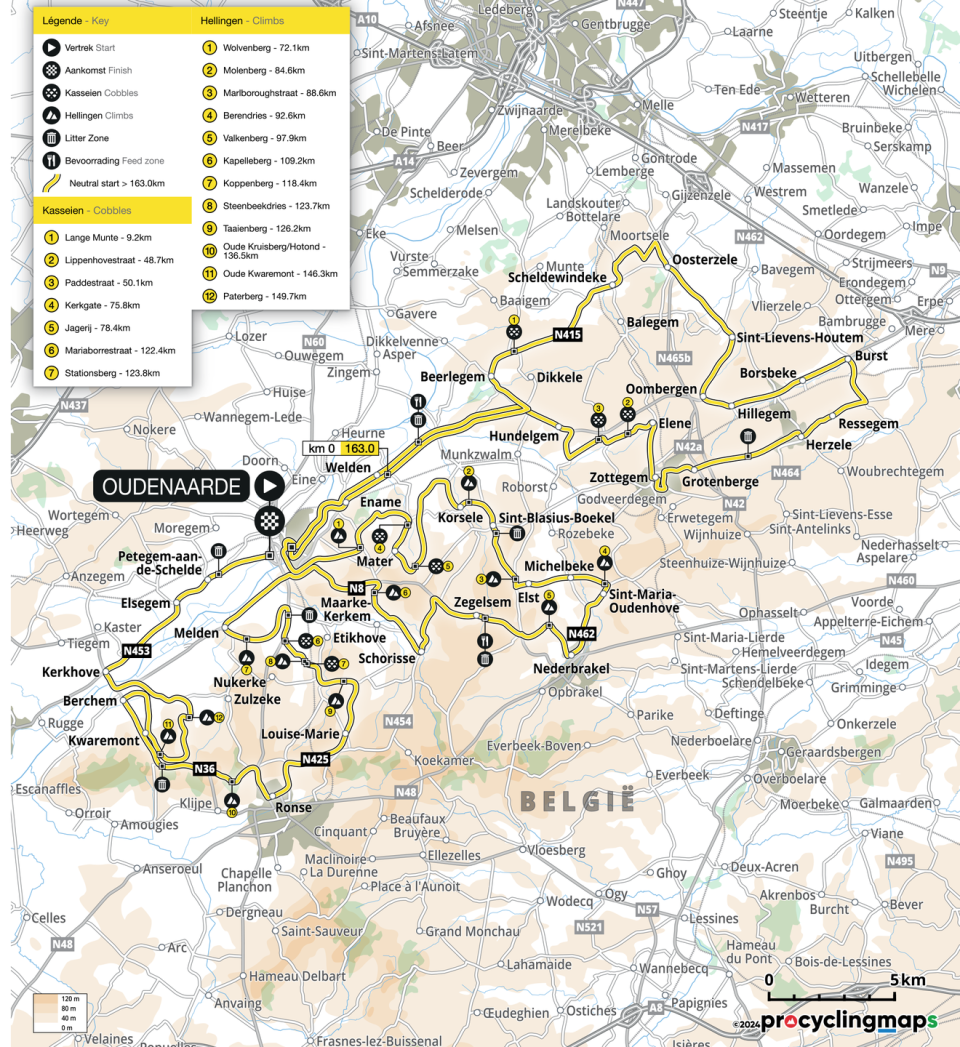
The 156km women’s race begins and ends in Oudenaarde. The course resembles a mutated clover leaf, and the women’s peloton crosses twelve of the climbs and seven sectors of cobblestones from the men’s event, including–for the first time two years ago–the Koppenberg.

In fact, beginning with Koppenberg, the women’s and men’s final loops are identical, with five more climbs coming in quick succession and the Oude-Kwaremont and the Paterberg providing two final launchpads for riders hoping to escape and win the Flemish Monument.
How to Watch de Ronde van Vlaanderen
If you subscribed to FloBikes ($150/year or $30/month) before Ghent-Wevelgem or Dwars door Vlaanderen, then you’re all set to watch the Tour of Flanders. Both the men’s and women’s events will be available live and on-demand via FloBikes.com, the FloSports IOS app, and the FloSports app for Amazon FireTV, Roku, and Apple TV.
Clocks spring forward in Europe on Sunday, so fans on the east coast will be six hours behind the event’s local time. We’ll be up early to watch the men as they hit the Oude Kwaremont for the first time (about 7:30 a.m. EDT). If that’s too early for you, set an alarm for about 9:30 a.m. EDT, the second passage over the cobbled ascent and the moment when the race is expected to explode.
The men’s race should finish around 10:45 a.m. EDT, at which point the women (depending on their average speed) should be nearing or just over the Koppenberg. The women’s race should finish around 11:45 a.m. EDT, which means you’re in for at least 2+ hours of fantastic racing.
What Happened Last Year
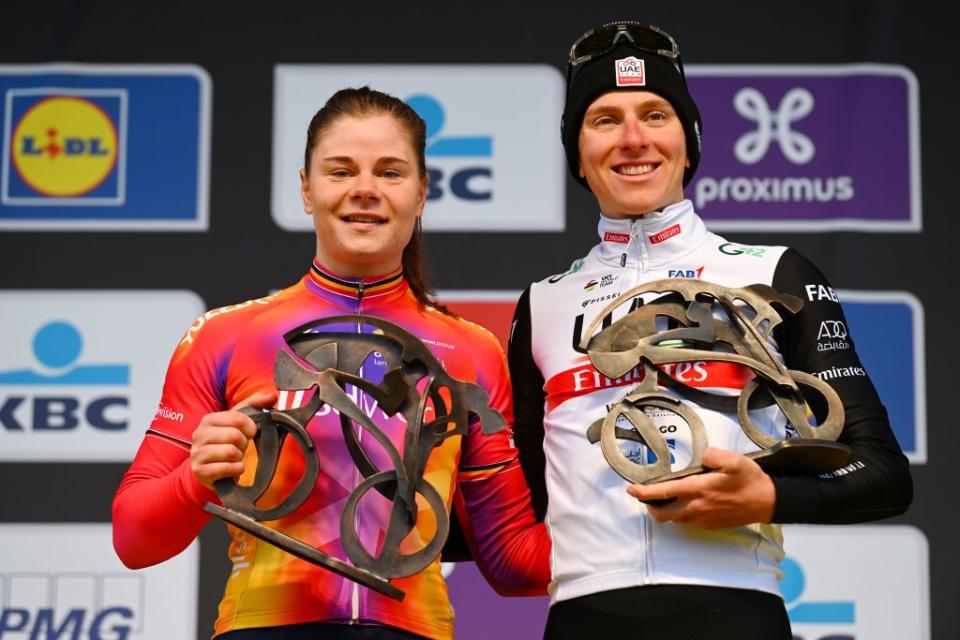
After finishing fourth in 2022, Pogačar returned to the Ronde last year, dropping the rest of a dream breakaway of riders that included the Netherlands’ Mathieu van der Poel (Alpecin-Deceuninck), Belgium’s Wout van Aert (Jumbo-Visma), and Denmark’s Mads Pedersen (Lidl-Trek) on the last ascent of the Oude Kwaremont. The Slovenian rode along to the finish to become the third male rider in history–and the first since Belgian legend Eddy Merckx–to win the Tour de France and the Tour of Flanders.
But the Belgian fans didn’t go home unhappy. A little while after Pogačar crossed the finish line, home favorite Lotte Kopecky (SD-Worx) defended her title from 2022, capping off a true team effort in which she and the Netherlands’ Demi Vollering finished first and second.
Riders to Watch
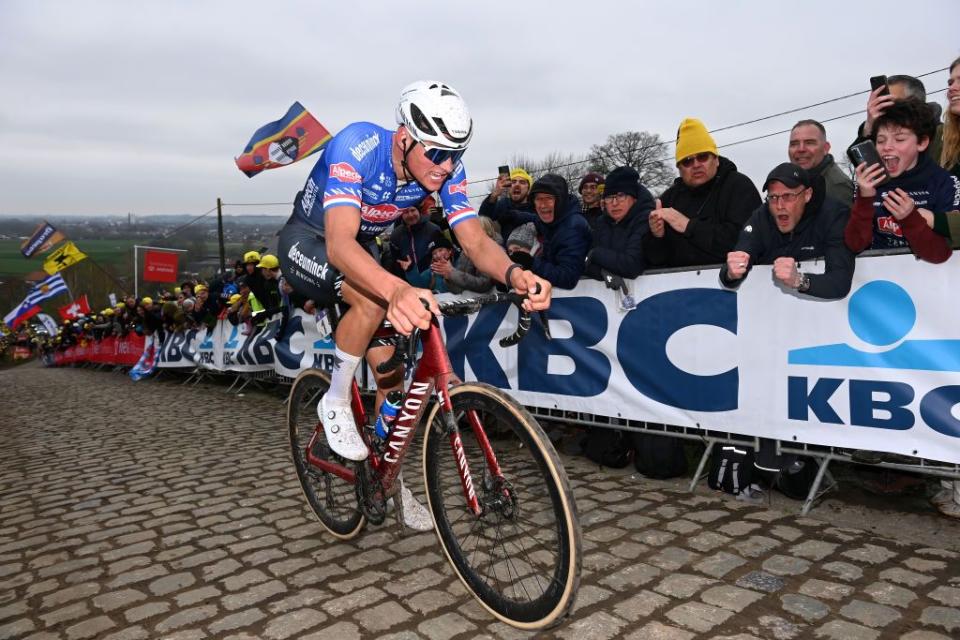
Mathieu van der Poel (Alpecin-Deceuninck)
With Pogačar not defending his title and van Aert breaking his collarbone and a few ribs in Wednesday’s Dwars door Vlaanderen, it looks as if this year’s Tour of Flanders is van der Poel’s race to lose.
Even before Wednesday’s high-speed crash, van der Poel was the top favorite. The Dutchman has won the Ronde twice and never finished worse than fourth in the five times he’s raced it. He’s again built the first part of his season around winning the Flemish Monument for a record-tying third time, and three race days into his spring he’s proven that he’s ready with a tenth-place finish in Milan-Sanremo, a dominating victory in last Friday’s E3 Saxo Bank Classic and a second-place finish in Sunday’s Ghent-Wevelgem. Anything less than a victory will be a major disappointment for the Dutchman and his team.
Mads Pedersen (Lidl-Trek)
Pedersen has a lot going for him in Sunday’s Tour of Flanders. He’s an experienced contender, having finished second in 2018 and third last year. He’s also the captain of Lidl-Trek, the strongest team in the classics peloton at the moment. But most importantly, he knows he can defeat van der Poel after beating the Dutchman in a two-up sprint to win Sunday’s Ghent-Wevelgem.
Now the bad news: the Dane went down in the crash that took out van Aert in Wednesday’s Dwars door Vlaanderen. He was able to get back on his bike and continue the race (he later DNFed), but his teammate, Belgium’s Jasper Stuyven, wasn’t as lucky. That’s a big loss for Lidl-Trek, Stuyven is a former Monument winner who has proven to be a valuable ally to the Dane so far this spring.
Matteo Jorgenson (Visma-Lease a Bike)
Stranger things have happened, right? It’s been a nightmare couple of weeks for Visma-Lease a Bike’s classics squad as crashes and illnesses have gutted the team, forcing them to take a bit of a “last man standing” approach to Sunday’s Monument. Luckily, the last man standing at the moment is a pretty good one: American Matteo Jorgenson, who won Paris-Nice in early March and then Wednesday’s Dwars door Vlaanderen semi-classic.
With van Aert and several more of the team’s riders forced to sit out Sunday’s race, Jorgenson has clearly earned the right to lead the team instead. Ninth in Flanders last year, he also scored top-5 finishes in the last two editions of the E3 Saxo Classic, a mini-Tour of Flanders that many riders use as their Tour of Flanders dress rehearsal. He’s no Wout van Aert (yet), but he’s the team’s best rider at the moment and a solid contender to at least finish on the podium.
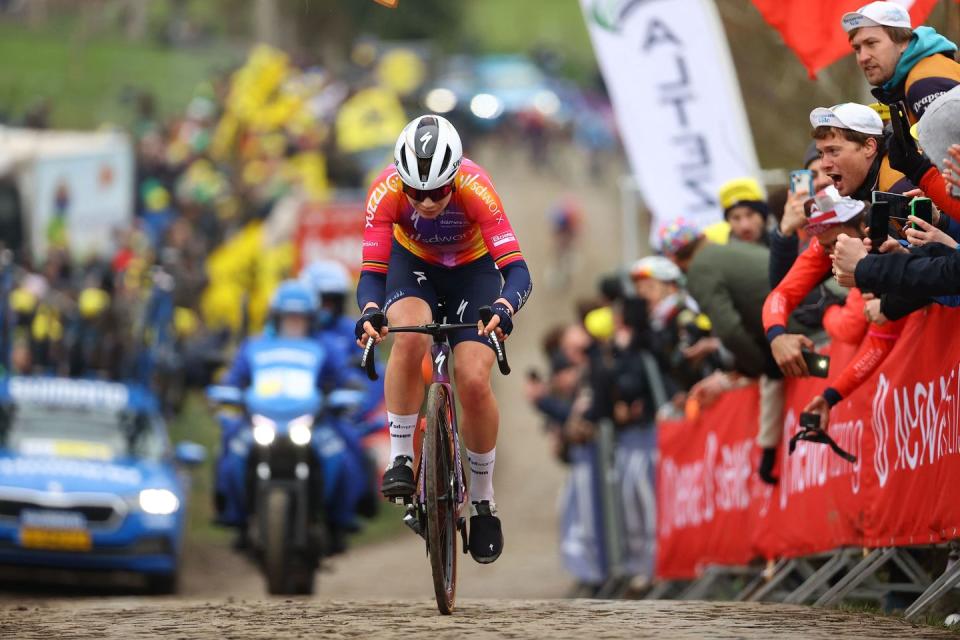
Lotte Kopecky (SD Worx-Protime)
The two-time defending champion, Kopecky will likely be the focal point of an SD Worx-Protime squad that should also include the Netherlands’ Demi Vollering, who was second behind her teammate in last year’s edition.
Kopecky “only” finished fourth in Wednesday’s Dwars door Vlaanderen, as she found herself isolated and outnumbered in the leading group at the end of the semi-classic. But with two wins and two second-place finishes in major one-day races so far this season, she’s still the woman to beat despite Wednesday’s setback (if you can call fourth-place a setback). A victory Sunday would make her the winningest rider in the history of the women’s Ronde, and the first rider–male or female–to win the race three years in a row.
Marianne Vos (Visma-Lease a bike)
Vos won the Omloop Het Nieuwsblad in late February and then took a break after finishing ninth at Strade Bianche in early March. Well, it looks like the decision has paid off as the 36-year-old won Wednesday’s Dwars door Vlaanderen, putting herself firmly on the list of favorites for Sunday’s Tour of Flanders, a race she won in 2013.
What was most impressive about Vos’ win Wednesday was the manner in which she did it. Lidl-Trek had two riders–Italy’s Elisa Longo Borghini and the Netherlands’ Shirin van Anrooij–in the leading breakaway of six. When van Anrooij attacked, Vos didn’t wait. She quickly covered the move, not worried about a possible counter-attack from Longo Borghini if the Dutch riders were caught.
It’s often said that in order to win races you have to be willing to lose them, and Vos illustrated the wisdom behind the cliché on Wednesday. With SD Worx-Protime and Lidl-Trek expected to have the two strongest teams in Sunday’s race, Vos might have to prove it right yet again.
Elisa Longo Borghini (Lidl-Trek)
The second Lidl-Trek rider to make Wednesday’s winning breakaway, Longo Borghini, tried to join van Anrooij off the front with Vos at the end of Dwars door Vlaanderen but couldn’t quite close the gap. Regardless, she’s still a top contender for Sunday’s Tour of Flanders, a race she won in 2015. While they didn’t win the race Wednesday, her team found a winning formula for beating SD Worx-Protime: isolate and out-number them, and then grind them down. Look for them to try a similar approach on Sunday, with hopefully an even better outcome.
Other Riders to Watch
Matej Mohorič (Bahrain-Victorious), Stefan Küng (Groupama-FDJ), Alberto Bettiol (EF Education-EasyPost), Demi Vollering (Team SD Worx-Protime), Shirin van Anrooij (Lidl-Trek), and Katarzyna Niewiadoma (Canyon//SRAM Racing)
You Might Also Like
